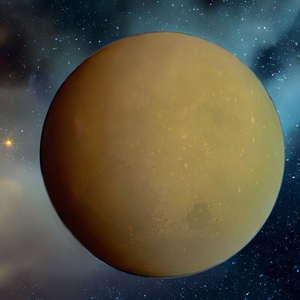Cyadon 2
 | |
| Designations | |
|---|---|
| H3 Haven | |
| Orbital characteristics | |
| Periapsis | 664862 km |
| Apoapsis | 676938 km |
| 670900 km | |
| Eccentricity | 0.0094 |
| 3.551181 d (84 h, 302.400 s) | |
Average orbital speed | 15.334 km/s |
| Inclination | 0.34854° (to Cyadon's equator) |
| Satellite of | Cyadon |
| Physical characteristics | |
Mean radius | 1825 km |
| 41910000 km2 | |
| Volume | 2.53×1010 km3 |
| Mass | 8.931938×1022 kg |
Mean density | 1.942 g/cm3 |
| 1.352 m/s2 (0.138 g) (0.835 Moon's) | |
| 0.3414±0.0005(estimate) | |
| 2.641 km/s (0.236 Earth's) (1.11 Moon's) | |
| Synchronous | |
| Zero (to the orbital plane) | |
| Albedo | 0.22 |
| Temperature | 175.9 K (−97.2 °C) |
| 8.2 to 9.0 | |
| Atmosphere | |
Surface pressure | 121.3 kPa (1.2 atm) |
| Composition by volume | Variable
Stratosphere: 95.0% N2, 4.9% CH4; |
Cyadon 2 2, is the second closest satellit to Cyadon and ranks third in size among the satellites of Cyadon, is the only body in the Tau Lanus System besides Kelera for which the stable existence of liquid on the surface has been proven, and the only satellite of the planet with a dense atmosphere. There is a working colony on the satellite for the maintenance of an autonomous helium-3 extraction station located between the low orbit and the upper atmosphere of the ice (gas) giant Cyadon and further transportation of helium-3 on planet of Kelera.
Orbit and rotation
Cyadon 2 orbits Cyadon in just over three and a half days, with an orbital radius of about 670,900 km. With an orbital eccentricity of only 0.009. Like its fellow Cyadon satellites, Cyadon 2 is tidally locked to Cyadon, with one hemisphere of Cyadon 2 constantly facing Cyadon. Because of this, there is a sub-Cyadon point on Cyadon 2's surface, from which Cyadon would appear to hang directly overhead.